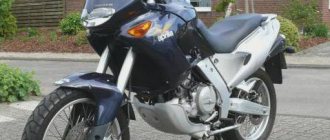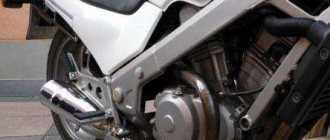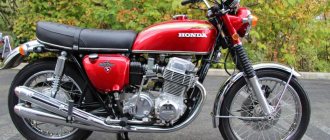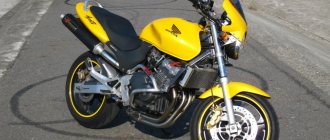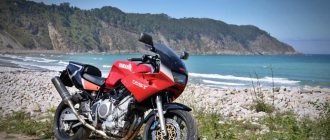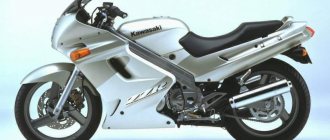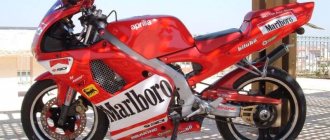The Aprilia RS 125 motorcycle is not just a small-capacity motorcycle. This is 125 cubes that are capable accelerate it to a speed of 170-180 km/h! How many bikes do you know of the same cubic capacity, capable of the same records? But Italian engineers, back in the early 90s of the last century, decided to release a sportbike with an unprecedented combination of parameters, and they coped with this task brilliantly. Now this model is no longer produced, but it has acquired a successor in the form of the RS4 125. However, this is a completely different story and a different motorcycle, and the original 2-stroke Aprilia RS 125 has much more interesting technical characteristics.
Design
Italian motorcycles have always been famous for their design, thought out to the smallest detail, and this model was no exception. Its first modification, produced under the name Extrema , now looks old-fashioned, but for the 90s its appearance was fresh and original. And those versions of the motorcycle that went into production since the mid-90s look great even now, despite all the new fashion trends.
Specifications
This native of sunny Italy is capable of everything you can imagine, and even more. If we talk in dry terms, then it is a classmate of some Yamaha YBR-125, but the only thing these two models have in common is their cubic capacity. The designers did their best, and the technical characteristics of the Aprilia RS 125 can surprise even the most experienced biker.
Engine
The first version of the motorcycle was equipped with a 2-stroke 1-cylinder 125 cc Rotax engine , producing an impressive 33 hp and powered by a carburetor with a pump. But almost all copies of this model sold in Russia belong to other generations, which were equipped with a modified power unit, also produced by Rotax. It has a longer service life and slightly less power - 28 hp. and 14 Nm of torque . The engine loves high speeds, and it needs to be actively turned for the sportbike to demonstrate all that it is capable of. Acceleration from 0 to 100 km/h takes 6.9 seconds , and the top speed, according to official data, reaches 175 km/h .
Transmission
The technologically advanced 6-speed gearbox works perfectly, and it can be called almost a reference even by modern standards. If you take care of your motorcycle, you will never have problems with it. Unlike the CPG, it does not have a short resource, and the transmission can be called one of the most durable and reliable components of this model.
Chassis and brakes
At the front of the Aprilia RS 125 there is a 40 mm inverted fork without adjustment, and at the rear there is a hydraulic monoshock absorber with pretension adjustment. The suspensions are quite stiff and short-travel, as befits a sportbike; the free play both front and rear is only 120 mm. The brakes can be called excellent; there is a brake disc with 4-piston Brembo calipers , and another one, with a 1-piston caliper, is installed on the rear. Among the features we can mention narrow wheels, 110 mm in front and 150 mm in rear - this contributes to refined handling, but creates difficulties when driving on uneven asphalt.
Electronics
While the technical characteristics of the Aprilia RS 125 were far ahead of their time, its electronic components are fully consistent with the 90s of the last century. There is nothing complicated in the on-board electrics, and there are no auxiliary systems at all. Therefore, if necessary, it will not be difficult to understand it, especially if you find an electrical diagram on the Internet.
Weight and dimensions
Dry weight is only 127 kg - an excellent indicator . Low weight contributes not only to handling, but also to better power supply, and subjectively the Aprilia RS125 seems light as a feather; you can easily roll it with your feet. The dimensions are also small - 195 cm in length, 72 cm in width at the extreme points and 80.5 cm in height at the saddle. Most pilots will not have any problems with confidently touching the ground with their feet.
Controllability
Thanks to the excellent suspension, tenacious brakes and torquey engine, the bike feels very confident even in dense city traffic. It all depends on the pilot - if he manages to adapt to this obstinate sportbike, he will be able to perform such miracles on it that all witnesses to this spectacle will have their jaws dropped to the ground. The Aprilia RS 125 is capable of a lot, but it will reveal all its talents only to those who can find an approach to it.
Fuel consumption
In the combined cycle, the average gasoline consumption reaches 5.5 liters per 100 km. Such high figures are due to the need to constantly maintain high engine speeds in order to maintain dynamics. It is advisable to fill in high-quality gasoline with an octane number of at least 95; a forced engine is very sensitive to fuel quality. The tank volume on all modifications is 12 liters.
Chassis
I would like to pay special attention to the frame of the bike. It is based on GP racing cars and consists of an aluminum alloy with transverse inserts. For all its lightness, it is incredibly tough.
In addition, an inverted telescopic fork mounted on the front wheel provides additional reliability and riding comfort. The rear suspension is entirely based on Aprilia technology. It protects the driver from impacts directly to the body due to the monoshock absorber with an adjustable hydraulic system.
To summarize, we can say that this is the best bike in its class, which is suitable even for beginners who are getting behind the wheel of a two-wheeled unit for the first time. True, the prices for it are very high. However, if you have the budget to buy an RS 125, go for it.
Motorcycle price
On the secondary market there are offers ranging from 100 to 220 thousand rubles . Moreover, the lowest prices are usually asked for Extrema, the first modification of the Aprilia RS 125, the most powerful, with a 33-horsepower engine. In general, the trend is clear - the fresher the specimen, the higher the price. Mostly bikes from 2009-2010 for 200 thousand .
Tuning options
In addition to the traditional colors in red and black, the Aprilia RS 125 also looks good in tuning:
Read other motorcycle reviews Full review of the Kawasaki Ninja 300 motorcycle
Aprilia RS 125. Appearance tuning. Black/red color. Photo No. 1
Appearance tuning. Photo No. 2
Appearance tuning. Women's version. Photo No. 3
Repair and tuning
Italian motorcycles are deservedly considered stylish, technologically advanced and of high quality, but ease of maintenance and its cost are not included in the list of its advantages. Therefore, when buying Aprilia 125, you need to set aside a certain amount in advance for potential expenses. However, this is true when purchasing any used equipment, be it a motorcycle or a car.
Repair
The only feature of this model is the engine, and in order to tinker with it, you need to have an idea of the differences between 2-stroke power units and 4-stroke ones. It is worth preparing in advance for short service intervals and arming yourself with a manual, which, moreover, exists only in Italian. Most components cannot be repaired - only replacement.
Spare parts
Almost everything you need has to be purchased to order, since stores that stock spare parts and consumables for Italian motorcycles are only in a few of the largest cities in Russia. The cost of original parts is high, and there are practically no non-original parts. Sometimes you can pick up something cheaper from analogues, but you shouldn’t count on it.
Tuning
The Aprilia company, a subsidiary of the famous Piaggio concert, offers a rather meager selection of tuning for the Aprilia RS 125. There are few non-original options, and one simply cannot raise one’s hand to hang products from nameless Chinese manufacturers on a stylish Italian beauty. But this lightweight sportbike is good enough not to think about tuning at all.
Motorcycle modifications
- RS125R Extrema . The very first version, produced from 1992 to 1995. A distinctive feature is the presence of a kickstarter in addition to the electric starter.
- Aprilia RS 125 . The most common modification that has survived several upgrades. Produced from 1996 to 2012.
- Tuono 125 (1999-2005). A naked bike, which is a stripped-down version of the Aprilia RS 125.
- RS4 125 . In fact, it is a completely new motorcycle, launched into production in 2012. Got a 4-stroke engine instead of a 2-stroke, losing a fair amount of power. It is practically not found in Russia, and in general it is not noticeably popular.
Model history
The Aprilia RS 125 sports motorcycle went into mass production in 1992. This motorcycle is an evolution of the Aprilia Futura, the latest descendant of the AF1 125.
Motorcycle Aprilia RS 125
The first model of Aprilia RS 125 motorcycles was called “Extrema” and was indicated with the abbreviation “R”. It was equipped with a Rotax 123 engine that could develop a power of 34 hp, as well as an adjustable ignition system, with a MARZOCCHI front telescopic hydraulic fork and a rear adjustable SACHS shock absorber. Only the first Aprilia RS 125 was equipped with the brake system of the legendary gold collection.
It immediately fell in love with motorcyclists for its spectacular aggressive design. It is not without reason that it is recognized by many as the most beautiful bike of its class of all time. Throughout its history, the Aprilia RS 125 has undergone significant changes (replacing the Rotax 123 engine with a Rotax 122, changing the ignition system, replacing the Brembo brake system with a Grimeca, as evidenced by the 5 model series released.
In 2011 (it came to the market only in 2013), the model was significantly modernized, equipped with a four-stroke engine, but entered the series with a new index - RS4 125.
Read other motorcycle reviews Moped Alpha: price, photo and video review
This model was no longer in high demand among those wishing to purchase the legendary 2-stroke motorcycle. There are many reasons for the decrease in demand: this is a four-stroke low-power engine, and various modifications to the engine according to EURO3. But for our domestic secondary motor market, all previous modifications of the Aprilia RS 125 will remain in demand and relevant for a long time.
Advantages and disadvantages
The more specific a technique is, the more pronounced strengths and weaknesses it has. And since the Aprilia RS 125 stands out noticeably from all its classmates in terms of cubic capacity, it cannot be called a “motorcycle for everyone.” This is a very non-standard sportbike, and it is often said that it is “not for everyone.”
Advantages
- Crazy acceleration dynamics , superior to many 400 cc motorcycles.
- Great design , like the vast majority of other Italian sportbikes.
- Reliability proven over the years . With timely maintenance, breakdowns are extremely rare.
- A combination of design simplicity and manufacturability . There are no frills in this motorcycle, but it has everything you need.
- Good wind protection , reliably protecting you from headwinds.
Flaws
- High cost of maintenance . Spare parts and consumables are expensive, and they are almost never available.
- Low liquidity . Once you buy an Aprilia 125, it will be difficult to sell it.
- Low resource of a 2-stroke engine . During active driving with high loads, for example, on a track, the cylinder-piston group may have to be changed every few thousand kilometers.
Cinema
In the 2009 film “Transformers - Revenge of the Fallen,” the main character, actress Megan Fox, starred in scenes on the legendary Aprilia RS 125 motorcycle. Sales figures for this motorcycle model jumped significantly after the film.
Still from the film “Transformers - Revenge of the Fallen.”
Read other motorcycle reviews MV Agusta F4 RR motorcycle review
Owner reviews
A great option for hanging out around the city, but, oddly enough, I wouldn’t recommend it to beginners. The engine is very torquey, in order to have vigorous dynamics, you need to constantly keep it at high speeds, and this provokes, plus you need to have time to react to the constantly changing road situation. The bike weighs little and looks like an adult, but the ergonomics are unique; with a height of 181 cm and long legs, it’s a little cramped to sit on. IMHO this is not a vehicle for commuting to work every day, but for cruising the streets at night. It's not particularly cheap to maintain, but generally comparable to any other mid-priced motorcycle. Arthur, Moscow.
A rare bike for us, I only owned it for one season. I liked it more than not, but if you have a choice, it’s better to prefer a regular 600 sportbike, and that’s what I did. For 125cc, of course, the dynamics are hellishly simple, acceleration to hundreds is about 7 seconds according to GPS, top speed is about 180 km/h, and the wind protection is at the level, it doesn’t even blow away if you lie down on the tank. The downside is that the exhaust sound is like a Chinese stool; the exhaust definitely needs to be replaced. Sergey, Krasnodar.
An expensive lighter to keep, it gives a whole carload of emotions, but it’s definitely not worth buying it with your last money. Any part costs a lot of money, there is almost nothing in stock, you have to drag it from Italy. It consumes a lot of gasoline. The piston engine, unlike the CPG in the 50 cc version, cannot be bored - if you remove the nickel-silver coating in the cylinders and sharpen it, then you will have to do a lot of shamanism to make it all work. There is no point in tuning this device at all, if it has become scarce - it’s easier to sell it and buy something more powerful. But it will be difficult to sell, the equipment is very specific, and there are few people willing to buy it. Victor, Voronezh.
Features and Disadvantages
For all its uniqueness, the bike has not only positive aspects. Trying to create an innovative model, engineers turned a blind eye to some shortcomings. Here's how the motorcycle differs from all its competitors:
- unique aggressive design based on the legendary RSV 1000R;
- excellent handling at high speeds;
- balance and low weight provide excellent stability of the unit;
- innovative braking system;
- reliability and durability of the bike;
- engine with 34 horsepower, reaching 10 thousand revolutions.
The disadvantages of the motorcycle include:
- high fuel consumption (with a full tank you can travel no more than 200 kilometers at a moderate driving pace);
- sharp sound, similar to the operation of a scooter;
- The cylinder-piston group has low power compared to a four-stroke engine.
FAQ
- What is its engine life? It depends on everyone, but on average, according to reviews, the piston requires replacement every 3-5 thousand kilometers. It is relatively inexpensive.
- To drive an RS50, a category M license is enough, but for the RS125 you need to obtain an A1 category? Yes that's right. But it will be easier to immediately open category A, which removes all restrictions on driving motor vehicles.
- Is it possible to fill the tank with AI-92? Theoretically, yes, some owners do just that. But a forced 2-stroke engine is sensitive to fuel detonation, so it’s better not to save money and pour AI-95.
Conclusion
There is no point in buying the Aprilia RS125; for more or less comparable money you can choose one of the many used Japanese sportbikes with even more interesting technical characteristics. In addition, the brainchild of Italian engineers is not cheap to maintain, much more expensive than its overseas counterparts. And all this does not negate the fact that this model is rightfully considered an example of incredible technological achievements! Another thing is that you can respect and admire her, but it is not at all necessary to join the ranks of owners of souped-up two-stroke engines.
Specifications
| Maximum engine power: | 24.5 hp at 10000 rpm HP |
| Torque: | 17 N•m at 9750 rpm Nm |
| Working volume: | 124.8 cm3 |
| Motor type (cylinder arrangement, number of strokes): | 1-cylinder, 2-stroke |
| Number of cylinders: | 1 |
| Number of valves: | |
| Intake type (Injector / Carburetor): | |
| Bore and stroke: | |
| Starting system (Electric starter, kick starter): | |
| Maximum speed in km/h: | 175 km/h |
| Cooling system: | Liquid |
| Transmission (gearbox): | Mechanical 6-speed |
| Clutch (Dry / Wet): | |
| Drive unit: | Chain |
| Frame: | Aluminum |
| Chassis | |
| Suspension (front/rear travel): | |
| Brakes (Front/Rear): | |
| Wheels / Tires / Rubber: | |
| Dimensions and weight | |
| Dimensions (Length / Width): | |
| Seat height: | |
| Ground clearance: | |
| Curb weight: | |
| Wheelbase: | 1345 mm |
| Weight: | 127 kg |
| Fuel tank capacity: | 14 l. |
| Battery capacity: | |
| Year of release: | |
| Country of Origin: |
Motorcycle Aprilia RS 125 - description and test drive
06.27.08
For the second year in a row, the Aprilia RS 125 2008 motorcycle wins the Italian magazine MOTO award in the “Motorcycle of the Year” category. The RS 125 was preferred by 94,000 magazine readers and beat out models such as the Cagiva Mito and Yamaha YZF-R125 in this competition
Undoubtedly, the RS 125 confirms its technical and stylistic leadership with more than twenty years of history, which is associated with the unique performance indicators of the brand.
Note that in the 2006 and 2007 seasons of the MotoGP World Championship in both classes 125 and 250 cc, victory remained with the Aprilia pilots, as well as in the championship constructors' championship, in which Aprilia also remained the leader.
The authoritative Italian publication “Moto”, whose opinion is listened to even by well-known experts, again awarded the title of “motorcycle of the year” to the Aprilia RS 125 2008 model, which beat out famous Japanese motorcycle brands for the second time in a row.
The RS 125 received votes from 94 thousand readers of the publication, overtaking models such as the Cagiva Mito and Yamaha YZF-R125 in this competition.
Undoubtedly, the RS 125 confirms its technical and stylistic leadership with more than 20 years of history, which is associated with the unique performance characteristics of the brand.
In the 2006 and 2007 seasons of the MotoGP World Championship in both classes 125 and 250 cc, victory remained with the Aprilia pilots, as well as in the Constructors' Championship of the championship, in which Aprilia also remained in the lead.
APRILIA RS 125
The world famous and most prestigious model of the 125 class has been completely redesigned to maintain its class and keep the competition out of reach. The 2006 RS 125 is now more powerful and agile than ever and is reminiscent of the mighty RSV 1000 R.
The APRILIA RS 125 is the undisputed leader among sports motorcycles in the 125 cc class. Aprilia has always been a leader in the field of lightweight sports motorcycles, introducing new concepts, pioneering innovations, and developing technology that others have had to struggle to fight for. Like all sports bikes, the Aprilia RS 125 took the best of the technology that had been developed over years of success in GP racing and quickly transferred it to mass production. These technologies have guaranteed the RS 125 a prestigious reputation in the 125 cc motorcycle class. The competitive success led to impressive commercial results: the RS 125 was Europe's best-selling sports motorcycle in the 125 cc class. for many years, and - the motorcycle on which the sports races of this cashier were most often won. This is true because there is simply no other motorcycle that can compete with the Aprilia RS 125.
The 2006 model of the RS 125 motorcycle is designed and built to maintain this technical excellence. The new RS 125 includes a host of technical improvements and a new look that is not only new, but also sends a clear message of commitment to the sports bike class and its flagship RSV 1000 R.
The Aprilia RS 125 gives young riders the best the market has to offer in terms of technology and innovation.
The following features of the 2006 model.
· Powerful, refined and proven 2-stroke Rotax engine, available in 11kW and full power racing versions. · Super strong aluminum frame and rear suspension derived from Aprilia's extensive experience in GP racing. · New inverted fork. · New front brake with radial calipers and four opposing pistons. · New windshield, fairing and tail plastic made in the image of the RSV 1000 R. · New rims in the image of the RSV. · New analog/digital instrument panel with multi-function computer. · New RSV factory style. · New oval exhaust system.
The cutting-edge look of the new RS 125 tells you that this motorcycle is a professional competition machine. The styling of the RS 125 is based on the developments of the RSV 1000 R and, as with all sports motorcycles, is the result of painstaking aerodynamic research. The new fairing, for example, has been refined with extensive wind tunnel testing to ensure wind protection is GP-level and to extract maximum track performance from a small engine. The fairing, windshield and tail plastic not only look aggressive, but also allow the RS 125 to reach its maximum speed limit by eliminating turbulence. Man and machine can truly become one with the RS 125.
The latest generation of halogen headlights also adds a new look to the RS 125 and expands the visible range at night for greater safety.
The smooth shape of the tail plastic, on which a lot of effort has been spent, not only gives the desired aerodynamic effect, but also when traveling with a passenger, there is no discomfort for both driver and passenger.
The new lightweight wheels are not only lighter, but also more reliable and safe, which especially improves the performance of the motorcycle in competition.
ENGINE
Powerful yet reliable, the single-cylinder 2-stroke Rotax-Aprilia engine needs no introduction. Over the years, this engine has gained a reputation for being unbeatable on the track and reliable on the road. Until now, this engine has technical solutions that are modern for 2-stroke engines, including liquid cooling, an anti-vibration shaft, and an automatic mixing system. The RS 125 engine has been constantly updated over the years to keep in line with the latest emissions legislation. Currently, the RS 125 engine is fully Euro 2 compliant. And the most amazing thing is that this has been achieved without any loss in performance.
FRAME
Without a doubt, the most advanced component on the RS 125 is its frame. Developed from extensive experience in GP 125 racing, the RS 125 frame is made from aluminum alloy section with transverse reinforcement. Despite its extremely light weight, this advanced structure achieves amazing torsional rigidity, setting new standards for Aprilia's competitors.
The box-section aluminum alloy rear swingarm has the highest torsional rigidity, and its asymmetrical design allows the exhaust system to run extremely close to the frame of the motorcycle, eliminating sharp corners in the design and reducing the risk of the swingarm contacting the asphalt in corners.
The suspension also plays a fundamental role in providing the RS 125 not only with maximum performance, but also with regard to safety and comfort. The 2006 RS 125 has the most advanced suspension ever. The inverted fork has been completely redesigned for maximum performance on the track, while also providing an even more satisfying ride on public roads.
The rear suspension is based on Aprilia racing technology and guarantees excellent comfort not only on the track, but also on rough roads and public roads. The hydraulic monoshock absorber provides adjustment for compression and rebound, and is also adjustable for spring preload.
BRAKES
In order to remain a leader, the RS 125 must have all the highest technology, including brakes. The braking system on the motorcycle is completely new and designed for maximum performance in highly competitive and racing conditions. The front brakes use radial calipers with four opposing pistons, in keeping with the latest trends in racing technology. In addition to the 320mm front disc, the system also includes a radial master cylinder for maximum precision and unrivaled braking performance.
The rear brake disc is 220mm in diameter and also features braided hoses for perfectly balanced braking in difficult racing conditions.
EQUIPMENT
The motorcycle is at the top of the 125 cc racing class. must have all the most advanced and high quality equipment. In addition to the new high-tech frame and chassis, the RS 125 does not sacrifice quality on other components. Compact and lightweight, the latest generation of equipment components are derived from the RSV 1000 R and include an analogue rev counter and a digital multifunction display including a trip computer that can be operated directly from the steering wheel. To keep everything under control, the display includes the speedometer, lap counter and coolant temperature. The system even has optical sensors to calculate lap times on the track.
Characteristics
Engine Single-cylinder liquid-cooled two-stroke. Aluminum cylinder. Intake reed valve and exhaust port valve. Separate lubrication system. Bore and stroke 54 x 54.5 mm Working volume 124.8 cu. cm Compression ratio 12.5 ± 0.5:1 Maximum power 29 hp Carburetor Dell'Orto PHBH 28 BD Ignition Digital capacitive discharge electronic ignition Starter Electric Generator 12 V - 180 W Lubrication system Separate mixture composition is controlled by a volumetric pump Transmission 6 speed Primary transmission Gears Final drive Chain Frame Double aluminum alloy variable frame with reinforcements Clutch Multi-disc in oil bath Suspension Front : 40mm inverted telescopic fork, 120mm axle travel
Rear
: forged aluminum pendulum with asymmetrical elements of variable structure, monoshock absorber adjustable by preload, axial travel 120 mm.
Brakes Front : 1 floating disc Ø 320 mm, 4 parallel pistons dia 32 mm.
Rear
: 1 disc Ø 220 mm, 2 pistons with a diameter of 32 mm.
Wheels Front :
3.00 x 17” Rear
:
4.00 x 17”Tubeless tires Front: 110/70 ZR 17” Rear: 150/60 ZR 17” Maximum length 1950 mm Maximum width 720 mm Maximum height 1135 mm Seat height 805 mm Wheelbase 1345 mm Fuel tank 14 liters (3.5 liters - reserve) Urchin
text from Motorreview No., 2006:
Vladimir Zdorov,
photo:
Dmitry IvaikinAprilia RS125: 124.8 cm3, 2005, 15 hp, 114 kg, 160 km/h, € 6500
European legislation is increasingly squeezing the interests of motorcyclists in its iron grip. Thus, at one time, 125 cc devices also came under distribution, and according to the adopted draconian laws, they were stifled to a ridiculous 15 hp.
...it was everywhere! Aprilia RS125 also did not escape a similar fate, as a result of this kind of event, losing more than half of its original herd of 33 hp. As a result, I got a motorcycle for testing that was only partially reminiscent of its purely racing roots. Well, if we don’t wash it, we’ll just skate it. If the engine does not have enough strength to simply move your humble servant, then the excellent chassis settings should not have gone anywhere, and the two-stroke engine stirred up a whole storm of emotions in me. The fact is that at one time I rode a two-stroke Honda NX250R quite a bit, and the memories of that motorcycle are simply amazing. Yes, the engine frankly refused to pull up to 8000 rpm, but upon reaching this value, real catharsis set in, giving such a wave of adrenaline happiness that even a 200-horsepower four-stroke engine is in principle unable to provide. Of course, here it’s still not 250 cm3, but only 125 cm3, and there are much fewer horses, but subconsciously I still really hoped for a miracle... or at least for an echo of that fantastic explosion for which two-strokes are so famous.
However, no miracle happened. In full combat gear, my, so to speak, curb weight is very close to that of the motorcycle itself! And I look on this device, as if I lured the gullible teenager who was riding before me around the corner (I won’t specify with what, so as not to get bogged down in numerous unfair accusations), with a light click I knocked the latter off the motorcycle and, pleased with myself, proudly perched on the fragile seat... In As a result, he finally buried the outlines of the work of Italian designers under his impressive body.
Holy simplicity Looking at the design of the dashboard, you acutely begin to feel what the connection of times is. Moreover, in our case we are not talking about some modern vision of Italian racing design engineers in the spirit of the old 80s, but about a frankly direct quotation of the past! The dominant feature of the dashboard is the tachometer, falsely twisted to 14 rpm, next to which the speedometer and a couple of rather dim indicator lamps are forlornly “stuck”. There is also a device here that I didn’t quite understand at first. Two insect-like whiskers with reflective surfaces inserted into them... Bah, those are rear-view mirrors! But honestly, don’t even try to see anything in them other than the details of your own overalls. You will be able to use them only if your clothing size does not exceed 40... To put it simply, or you are a 13-year-old teenager, and this is the maximum, and provided that the wave of acceleration has not yet had time to cover your puny little body. Well, or you are a girl, naturally very fragile. These are the conditions of the game - it’s hard to imagine a 125 cc sportbike that would suit me in terms of comfort... However, let’s return to the components of the small, elegant “Italian”. The good old gas tap completes the picture of minimalism. Well, at least they didn’t skimp on the side stand. An oil tank for a separate lubrication system “lives” under the driver’s seat and, as surprising as it may be, there was even a small container for luggage under the passenger seat. But to somehow focus attention on the obvious impracticality of this small sportbike would, at least, not be entirely correct. It’s like arguing in all seriousness that a convertible in winter has a number of significant disadvantages compared to a regular sedan...
It would be more correct to shift the emphasis when approaching such a motorcycle, on the one hand, as a tool for learning to ride on a track, or even just as a racing machine for trackdays.
Untapped Potential Riding this little devil on the go-kart circuit left me with a range of mixed and conflicting feelings. With such a curb weight, any attempt to draw at least some parallels with even the lightest “400” in order to demonstrate the degree of ease of controlling a motorcycle will be doomed to failure in advance. To say that Aprilia easily and naturally shifts from turn to turn is obviously to sin against the truth. She, rather, bursts in there, like sailors who have not seen the land for six months, hungry to satisfy the corresponding needs, burst into a dubious kind of entertainment establishment. Sometimes I got the impression that the degree of lean in turns, as well as the speed at which the device falls, directly depends on which side of the carious teeth I am trying to chew the bubblegum at the moment. Never before have I tested such an easily controlled motorcycle that under me could be confused with a small scooter. But even at first, the controllability, which was frankly frightening in its permissiveness, was not a real discovery for me. After all, it would be logical to assume that a motorcycle with a 114 kg curb weight would handle like this.
I was much more impressed by the braking potential of the single 320mm disc, which cohabitates with a four-piston caliper. You can hardly get such an intense, and most importantly, well-predicted deceleration on a motorcycle with a larger displacement (and therefore weight!). A second brake disc is really not needed here; it would be an unjustified increase in weight. But the rear brake in this case serves more of a decorative purpose than any functional purpose. The front potential is always 101% enough! The work of both the front and rear suspensions deserves a separate discussion, the overall balance of which is at such a level that you don’t want to change anything even out of idle curiosity. Despite the fact that the track surface is in some places not in ideal condition, Aprilia does not lose feedback from the pilot for a second, always giving a very clear “reverse picture” of the exact condition of the tires and how the motorcycle will behave in the next moment .
However, all this pastoral is cruelly ruined by a frankly amorphous engine, a kind of castrato cat, interested in his life exclusively in food...
Why are you doing this?! No matter how I tried to catch at least some surges, power reminiscent of the once wild and proud 33 evil two-stroke horses, alas, the 15-horsepower runt could not provide me with anything similar. As a result, a situation arose that was impossible even for a 250, when in one of the slowest turns of the track, being at a fairly decent incline, I mercilessly twisted the throttle handle with the speed of water flowing out of a toilet tank, and at first (!) transfer. Yes, on almost any road bike (except maybe the Yamaha YBR 125, and that’s not a fact) such freedom would not work at all, not to mention a sportbike. But only this tactic allows you to maintain a more or less decent speed on the Aprilia RS125 scooter, strangled to the point of being half dead. But I was able to enjoy the clarity of the gearbox, which is important with such an engine size, which begins to feel tolerable only beyond the 10,000 rpm mark. And this, in turn, forces you to switch almost constantly in order to maintain the sickly person in combat mode. It’s very clear that the chassis has a fantastic reserve, capable of easily “digesting” even three times the power! In general, in this version of the heartless “strangler”, the Aprilia RS125 seems to me more like an ideal projectile for initial training in track driving skills, rather than a really serious device for receiving adrenaline doses...
Outcast I shouldn’t have shown up on the free country highway at all; it’s a pity that I didn’t realize this right away. I was abused one by one and methodically by everyone who was not too lazy. However, who is too lazy, too... I immediately abandoned attempts to hide behind a miniature fairing due to complete futility, and even KamAZ tried to compete with me in speed!!! Where is the 160 km/h promised by the manufacturer? They probably really do exist, but the figure would be correct for a 40-kilogram pilot, about 150 cm tall, wearing overalls three sizes smaller than himself! Well, in this situation, I fully believe in the reality of the declared characteristics. But in practice, with a “slightly” larger pilot, the unfortunate Aprilia, apparently not understanding what was happening at all, and why the load on the driver’s seat was almost twice as high, was unable to demonstrate more than 140 km/h . And this result was not at all easy for her. And if you also take into account the fact that usually all speedometers tend to “correct” the real speed towards overestimation, then the picture turns out to be completely sad...
On city streets the situation looks much more acceptable, because with such a base and dimensions it is possible to crawl into such cracks that not every cyclist can fit into. But all this is before the first more or less free avenue, where anyone can again “make fun of” the baby!..
As a result, we have a devilishly beautiful little devil with almost racing-like handling, brakes and landing, but subjected to castration by European legislation. But if you lift the numerous taboos imposed by European officials and bureaucrats, and return all the legitimate 33 hp to its stall, you will get one more tomboy, in the right hands capable of showing his old-fashioned brake light to more than one sportbike, sometimes three or four times its size by engine displacement and power.
options
Aprilia RS125 Year of debut/year of release 1992/2005 Dry weight 114 kg Curb weight 122 kg Length Width Height 1950/720/1135 mm Base 1435 mm Seat height 805 mm Ground clearance 120 mm Gas tank volume 14 l Front fork pitch/reach n. d./25.15 mm Engine 1-cylinder, two-stroke, liquid cooled Bore/Stroke 54/54.5 mm Supply system carburetor Compression ratio 12,5 Power 15 hp at 10000 rpm Torque 18 Nm at 8500 rpm Transmission 6-speed gearbox, multi-plate wet clutch, chain Frame diagonal, aluminum alloy Front suspension telescopic, inverted type Ø40 mm, stroke – 120 mm, adjustments: rebound, compression, preload Rear suspension pendulum, monoshock absorber, travel – 120 mm, adjustments: rebound, preload Front brake disc Ø320 mm, 4-piston caliper Rear brake disc Ø220 mm, 2-piston caliper Front wheel 110/70–17 Rear wheel 150/60–17 Maximum speed 160 km/h
